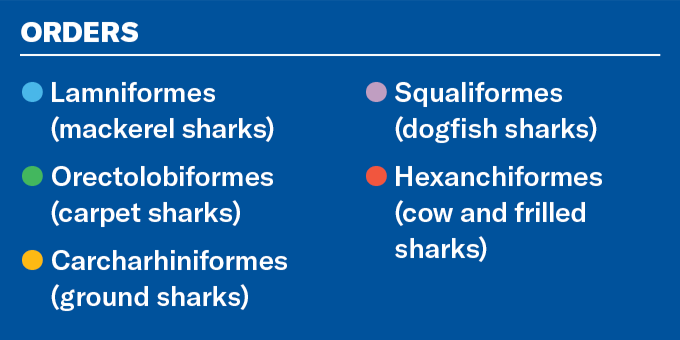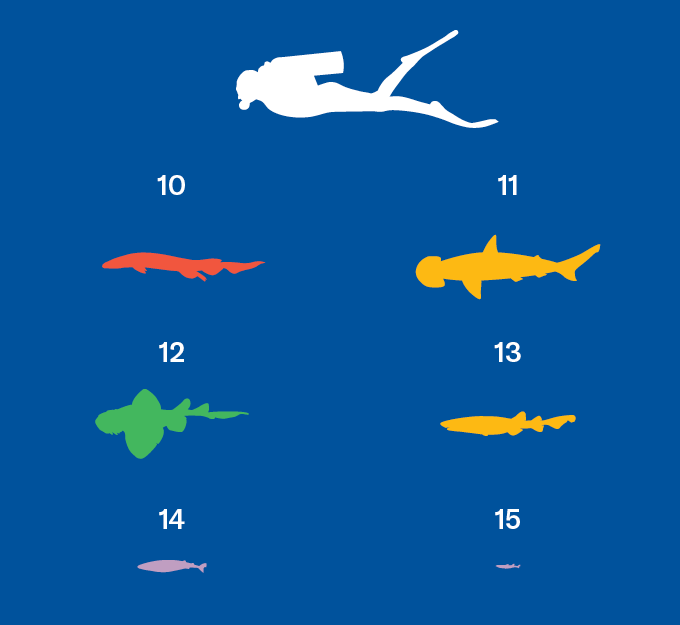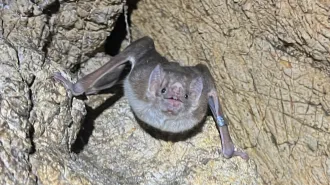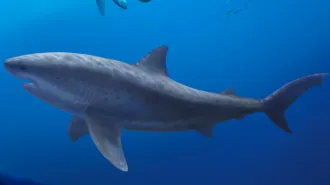Compare shark sizes on our infographic
There are over 500 species of shark. They can be as big as a bus or as small as a pencil

SHARK OUTLINES: BULLET_CHAINED/GETTY IMAGES AND B. PRICE
BACKGROUND: KIATTISAKCH/GETTY IMAGES
Since Jaws was released 50 years ago, great white sharks have, arguably, become the most recognized fish in the ocean. But despite their fame, they’re not the biggest shark species.
The largest shark alive today, the plankton-eating whale shark, typically grows to about 14 meters long for females and 9 meters for males, with one specimen reaching nearly 19 meters. Even bigger was the now-extinct megalodon, the largest shark that ever existed. But since no intact skeleton has been found, scientists can’t agree on its exact size. The latest estimate is about 24 meters.
While many huge sharks cruise the seas, the stereotype that they are all large hunters isn’t accurate. There are more than 500 shark species, and they come in all shapes and sizes. In fact, half of them are less than a meter long. The world’s smallest shark, the dwarf lanternshark, is about the size of a human hand.

“Sharks follow what’s known as the ‘two-thirds scaling law’ almost perfectly,” says Joel Gayford a marine biologist at James Cook University in Townsville, Australia. As sharks grow bigger, their volume increases more quickly than their surface area, he and his colleagues report June 18 in Royal Society Open Science. That explains why large sharks need different physical adaptations than small sharks do for regulating things such as temperature, breathing and resistance to climate change.
As Jaws celebrates its 50th anniversary, here’s a visualization of some of the most fascinating shark species — from the biggest to the smallest — and their approximate maximum lengths, all shown to scale.
The heavyweights

- Megalodon
Otodus megalodon
Extinct for 3.6 million years, these enormous sharks ate pretty much everything in the food chain, an analysis of their teeth suggests.
24 meters - Whale shark
Rhincodon typus
19 meters - Basking shark
Cetorhinus maximus
Although their gaping mouths stretch a meter wide, these harmless giants gorge themselves on tiny plankton in the water.
12 meters
Middle of the pack

- Greenland shark
Somniosus microcephalus
These sharks can live for hundreds of years. Using carbon dating, scientists in 2016 estimated one female was about 400 years old, meaning she was alive during the American Revolution.
7 meters - Great white shark
Carcharodon carcharias
6 meters - Common thresher shark
Alopias vulpinus
These predators stun their prey by whipping their long tail, which can be half the length of their body.
6 meters - Tiger shark
Galeocerdo cuvier
The “trash cans of the sea” eat anything: One was captured with a license plate and a gasoline can in its stomach.
5.5 meters - Bluntnose Sixgill Shark
Hexanchus griseus
5 meters - Goblin shark
Mitsukurina owstoni
This deep-sea weirdo has freakish protruding jaws that extend quickly to gobble up a meal before it escapes.
4 meters
The little guys

- Frilled shark
Chlamydoselachus anguineus
2 meters - Bonnethead shark
Sphyrna tiburo
This diminutive member of the hammerhead family can survive on a diet of up to 90 percent seagrass.
1.5 meters - Tasselled wobbegong
Eucrossorhinus dasypogon
1.3 meters - Swell shark
Cephaloscyllium ventriosum
When under threat, these bottom dwellers swallow water to balloon to twice their size, making it harder for predators to get them.
1 meter - Cookiecutter shark
Isistius brasiliensis
These tiny but mighty hunters prey on larger predators, like dolphins and other sharks, by removing a circular plug of flesh.
56 centimeters - Dwarf lanternshark
Etmopterus perryi
The smallest known shark on the planet grows no bigger than a pencil and has a glowing belly.
20 centimeters







